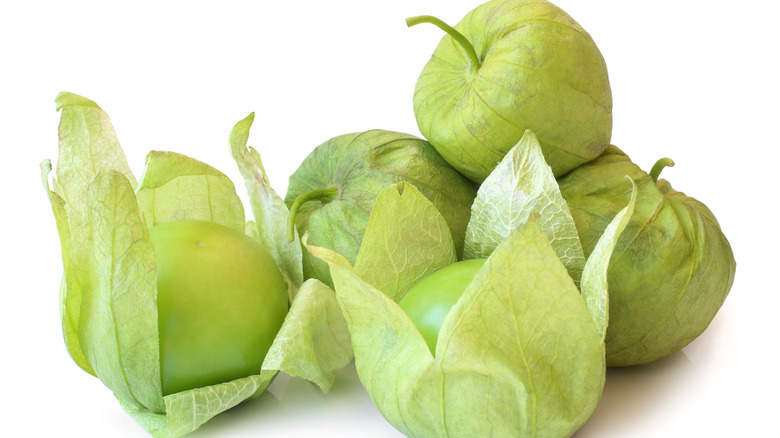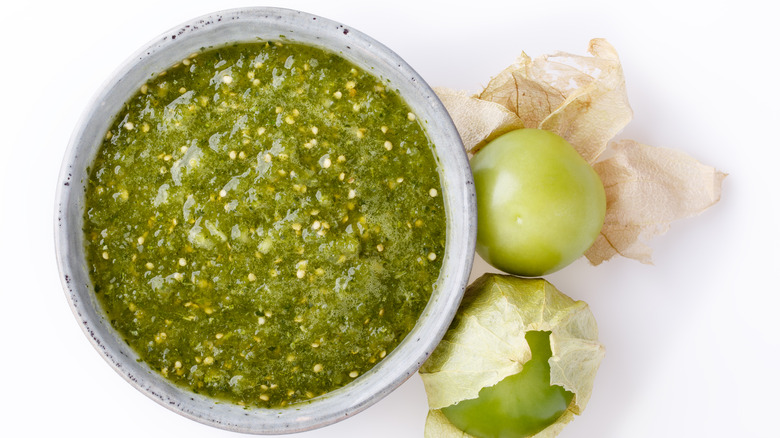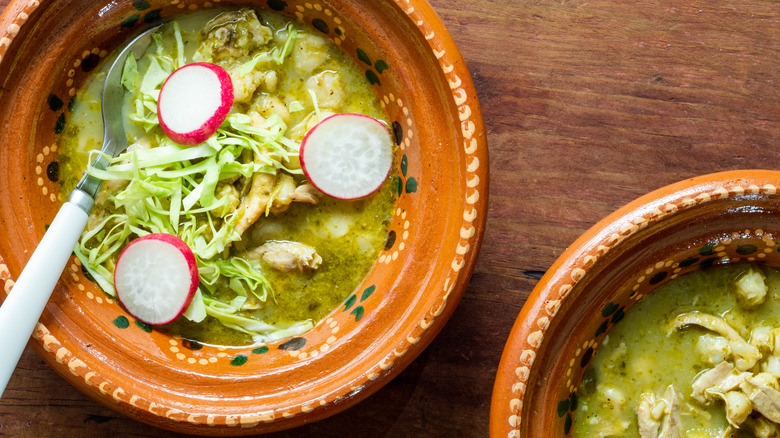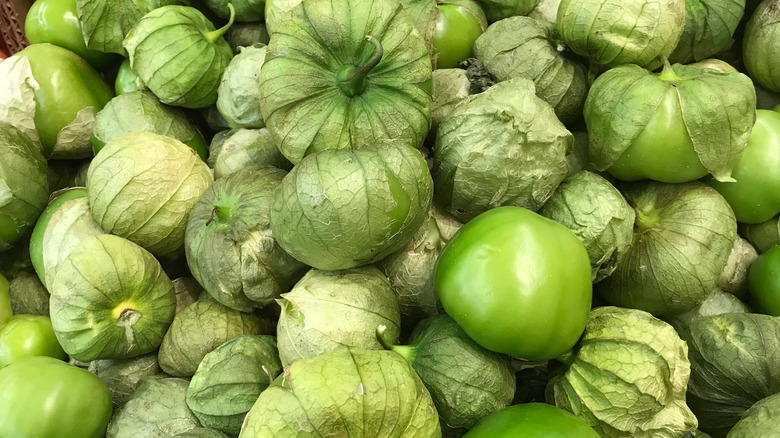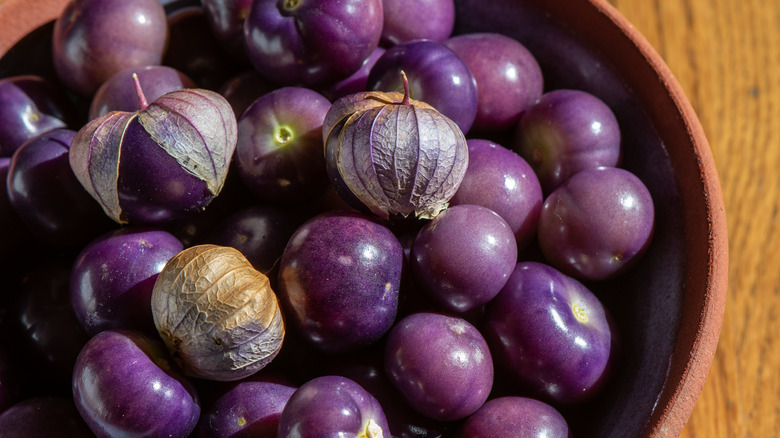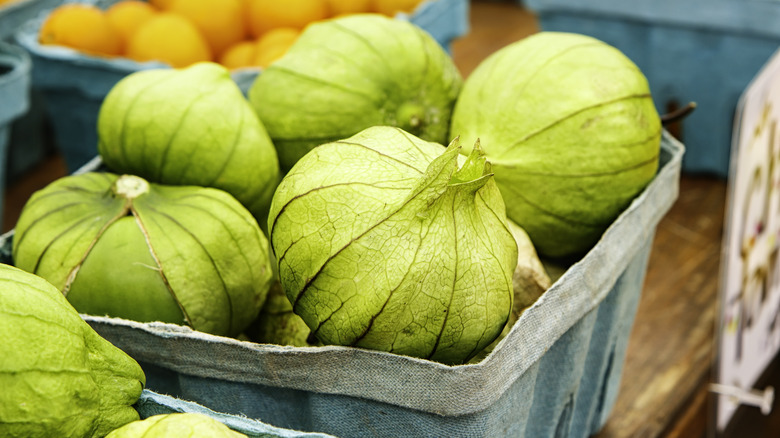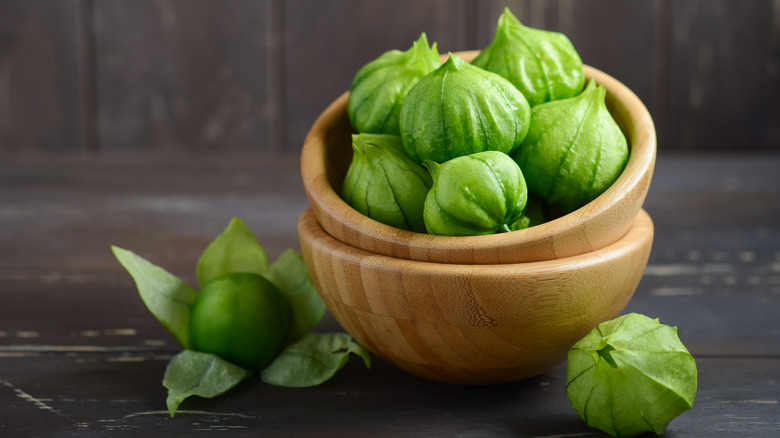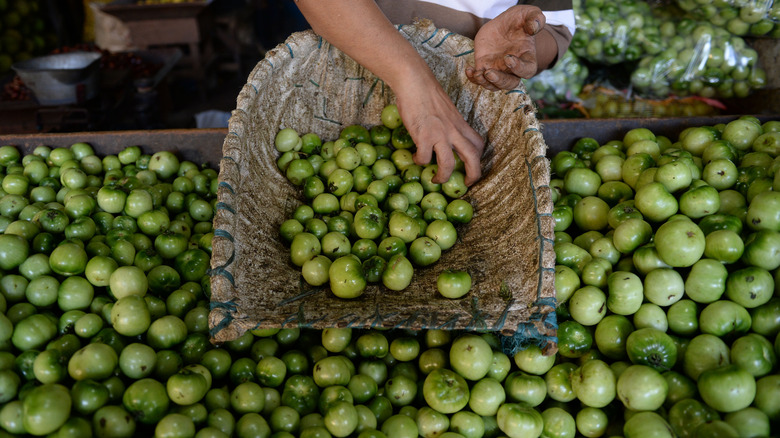What Are Tomatillos And Are They Spicy?
The name comes off as a cutesy endearing term for a tomato, but a tomatillo (Physalis philadelphica) has far more to offer. A tomatillo is sometimes referred to as a Mexican husk tomato because the golf ball-sized fruit actually grows inside a husk. Also true to this alternate name, tomatillos originate from Mexico and surrounding areas in Central America, and were once a relevant part of Aztec daily life in 800 B.C., explains MasterClass.
Today, tomatillos are now known as tomates verdes in Mexico. This translates to green tomato, although they are unrelated to green tomatoes found in America. Tomatillos change color as they mature, and can be found in green, yellow, purple, and red. However, they are most commonly consumed green, which contributes to their acidic citrus-like flavor. Though they are often used in spicy salsas, tomatillos themselves are not spicy.
Tomatillos belong to the nightshade family, which includes tomatoes, eggplants, peppers, and potatoes, but they actually have more overlap with cape gooseberries. They continue to grow wildly in Central America, and they can grow copiously in home gardens with sufficient sun.
The taste of fresh tomatillos vs. cooked tomatillos
Tomatillos can take on different flavors and degrees of tartness depending on their maturity and how they are prepared. When they are fresh and green, their acidity is highest, and are similar in flavor to a Granny Smith apple or green grapes. This acidic tang is a great way to add vibrancy to a dish, a bit like you would do with lemon juice. Tomatillos have bright vegetal flavors, which can work well to introduce an herbal note. Their flesh also remains firm when harvested, which adds crunch and texture, and can be great to mix into a salad. Contrary to popular belief, the fruit is not spicy, though it is often used as a base for hot sauces.
Meanwhile, cooked tomatillos take on a totally different personality. They are regularly broiled or roasted, though they can also be fried and boiled. The boiling process keeps the acidity fairly intact, and this is often the method used for making salsa verde, a tangy sauce. However, when tomatillos are roasted or broiled, their tart zippiness becomes a bit subdued and fruity, with juicy sweeter notes. Basically, no matter the level of acidity or sweetness you are looking for, there is a tomatillo out there ready to transform for your needs.
How to cook with tomatillos
Before beginning any recipe using tomatillos, it is necessary to remove the husks and rinse away the sticky residue that remains on the fruit's skin. Isabel Eats warns that the husk, leaves, and stem of the plant are actually toxic, so it's not just a light suggestion. Tomatillos are fine ingredients both raw and cooked. Raw, their tart acidity and crunch make a great addition to salad and guacamole, or even ceviche. You could even pair them along with cucumbers, lime juice, jalapeños, and vodka for a unique twist on a Bloody Mary. Since they have bright citrus flavors, tomatillos make a great match for chilis and other citrus fruits.
Probably the most well-known use for tomatillos is in salsa verde, a popular sauce that is fundamental to Mexican cuisine. There are two standard methods for making salsa verde: The tomatillos can be boiled for a subtler take, or they can be roasted or broiled to add some smokiness and char. Once you've cooked them according to preference, they are blended with onions, chiles, fresh cilantro, garlic, oil, and salt. Besides salsa verde, roasted, broiled, or fried tomatillos make great sides for meat dishes.
Nutritional information about tomatillos
Since tomatillos are a fruit, they definitely veer on the healthier end of the spectrum. Verywell Fit lists some star qualities which include being low calorie, and sodium, cholesterol, and fat-free. The site notes that the carbohydrate breakdown is part sugar and almost one gram of fiber per tomatillo. Organic Facts points out that the fiber content is beneficial for digestive health, as well as blood sugar regulation. In terms of micronutrients, Verywell Fit remarks that vitamin A, C, and potassium are present in decent quantities.
Food Facts points out that the tiny spheres also contain magnesium, niacin, phosphorus, and copper. Vitamins A and C, and additional phytochemicals in the fruit, may have antioxidant properties which help reduce cancer risk and inflammation, as well as improve eye health. Vitamin C is also known for its assistance in proper immune function. While tomatillos are mainly healthy with a multitude of benefits, they are part of the nightshade family. These can be an issue for people who don't tolerate high levels of alkaloids which sometimes contribute to inflammation. If this is the case, it is best to avoid tomatillos or discuss with your doctor.
Other varieties of tomatillos
There are two species of tomatillos, Physalisis philadelphia and Physalis ixocarpa, and each has its own set of cultivars and common colors. The standard tomatillo most readily found is the Toma Verde, about the size of a golf ball with a tart flavor. Though a large selection of varieties can be planted by gardeners and might find their way into a farmers market, most tomatillos sold are standard green ones.
Other green varieties include the Gigante (which is sweeter), the Miltomate (which is smaller), the quick-growing Rio Grande Verde, and the Green Organic (which is more of a yellow green color). There are also some yellow varieties, such as the Amarylla which is sweet and well suited for cooler climates, the Mexican strain, and finally the Pineapple which gets its name from its flavor. The purple varieties are often smaller, for example, the Organic Purple, De Milpa, Purple Coban, and Tiny From Coban.
Where to buy tomatillos
You can find tomatillos at local Mexican and Latin American grocery stores, as well as at farmers markets during their peak growing season in the summer and fall. Some well-stocked supermarkets in larger cities might also sell tomatillos in the fresh produce section. Tomatillos also come pre-roasted in cans, though their use becomes limited since they have already been cooked. However, they are suitable for any recipe that requires cooking the fruit — 11 ounces equates to about one pound of fresh tomatillos.
Once you've located fresh tomatillos, try to avoid rock-hard fruit, but choose some that are still firm. The site advises against those with shabby husks, especially if they have started to brown and dry. The fruit should mostly fill in the husk, which signals the tomatillos have matured. The smaller tomatillos will be sweeter, whereas the larger ones might border on bitter.
Finally, if you want to monitor your tomatillos from start to finish, then grow them yourself. They are suitable even for beginner gardeners as they don't face many issues, primarily needing sun, air circulation, and well-drained soil. However, you'll need to grow at least two plants because tomatillos require cross-pollination.
How should you store tomatillos?
Keep the husks on your tomatillos, until you are ready to use them. Since they grow as a protection for the plant, they are well equipped to keep the fruit fresh. Leaving tomatillos at room temperature on the counter is fine if they will be consumed within the week. For maximum freshness, storing them in the refrigerator keeps them intact longer. Though it will depend on the ripeness when you purchase them, you can keep tomatillos in the fridge for two to three weeks, loosely wrapped.
If you happen to have an abundant harvest or get carried away at the market, you can also freeze the whole fruit in a zip bag for up to six months. Another option when you're fully stocked with tomatillos is to roast and preserve some for easy use in future recipes.
What are tomatillo substitutes?
When you need the fresh tang of the raw fruit, you can use green peppers paired with something acidic such as lime juice, tamarind, or gooseberries. Alternatively, a green tomato could be used for soups or salsas, but the depth and sour bite won't be as present. Since fresh red tomatoes contain more water than tomatillos, chop them up and drain out the water before use. For some recipes, pairing green or red chilies with regular tomatoes and some lime juice can make a suitable replacement.
An even easier alternative is replacing your fresh tomatillos with the canned variety. They are readily available at grocery stores and come precooked, which makes them very easy to use in recipes. They will have a slightly different texture than fresh tomatillos, but they will still give your meal just as much delicious flavor.
